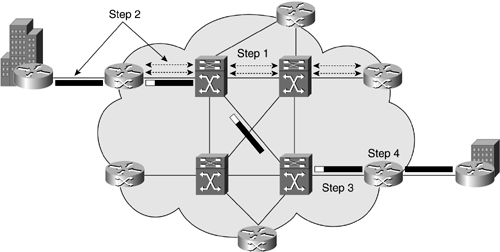MPLS Operation
Figure 21-3 illustrates how MPLS operates in a service provider network.
Figure 21-3. MPLS Operation

MPLS operation follows these steps:
The network routers and switches build routing tables as these same routers/switches participate in interior gateway protocols for example, Operator Service Position System (OSPF) throughout the service provider network. LDP creates label values between adjacent (connected) devices, using the routing topology in the LDP tables (learned from LDP). This operation creates LSPs between destination endpoints. Where ATM permanent virtual circuits (PVCs) require manual VPI/VCI, MPLS labels are automatically assigned via the LDP.
Packets enter the network where the ingress (point of entry) Edge LSR determines which Layer 3 services are required, such as QoS or bandwidth management. Based on these routing and policy requirements, the Edge LSR selects the labels and applies them to the packet headers before forwarding the packets across the network.
The LSR in the core reads each packet's label, replacing each label with a new one, and then forwarding the packet to the next hop in the path. These labels are maintained in the LSP tables.
The egress (point of exit) Edge LSR removes the packet's label, reads the packet header, and forwards the packet to its final destination.
The MPLS labels are looked up in the core network router/switch switching tables. These core network routers/switches hold Layer 3 (Network layer) information, enabling each switch to apply the required services to each IP packet. These switching tables are pre-calculated, not requiring packets to be reprocessed at each network hop. This only makes it possible to separate and classify traffic types, such as best-effort traffic from mission-critical traffic.
Figure 21-4 illustrates how packets are forwarded through an MPLS network.
Figure 21-4. MPLS Packet Forwarding

Following are the packet forwarding steps shown in Figure 21-4:
A packet arrives at the (ingress) Edge LSR.
The LSR reads the packet for the destination prefix, 128.89.
The Edge LSR then looks up the destination address in the switching table and inserts the corresponding label 4; then forwards it out interface 1.
The LSR in the core receives the packet on interface 2 with Label 4 and looks up its match in its switching table.
The core LSR replaces label 4 with label 9 and forwards it out interface 0.
The egress LSR receives the packet on interface 1 and looks up the corresponding label (label 9) in its table.
The egress LSR table says to strip label 9 and forward the packet out interface 0.
The sending and receiving customers are unaware of these MPLS label transitions while they are sending and receiving an IP packet to or from the network service provider. The customers are concerned about the network service provider meeting the promised Service Level Guarantees (SLGs), and it is MPLS that enables the service providers to meet these SLGs.
EAN: 2147483647
Pages: 269